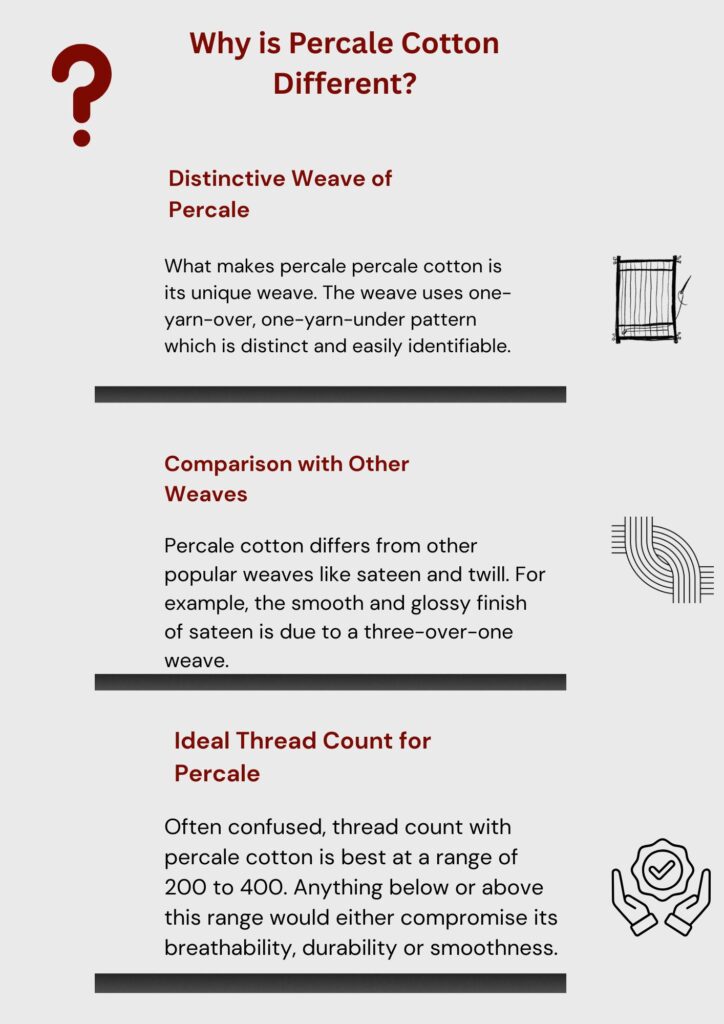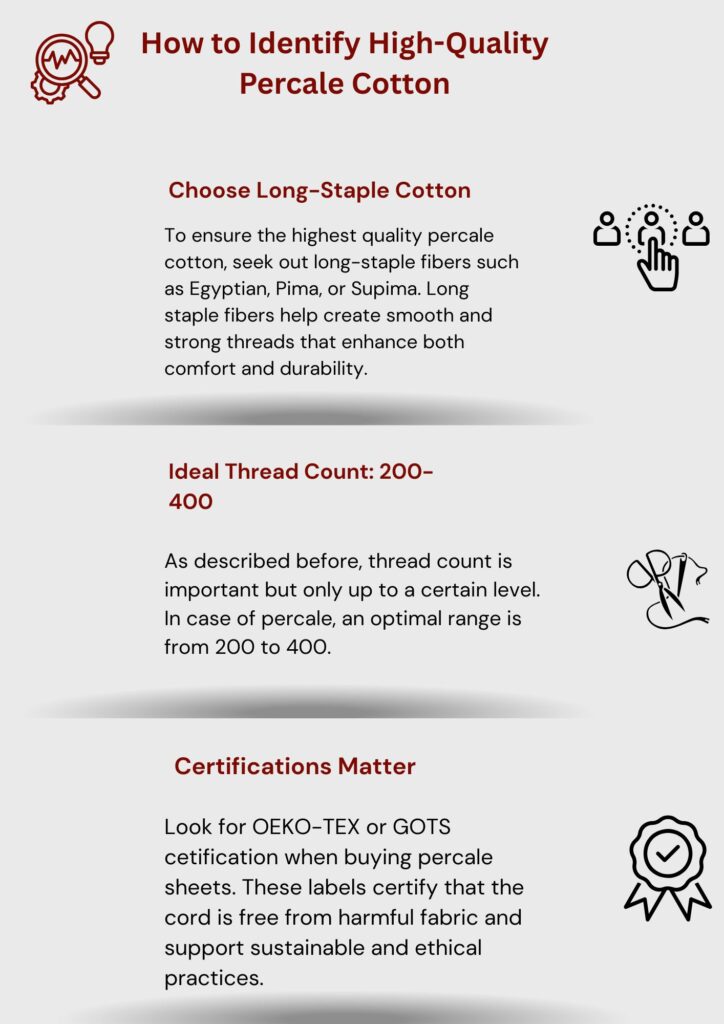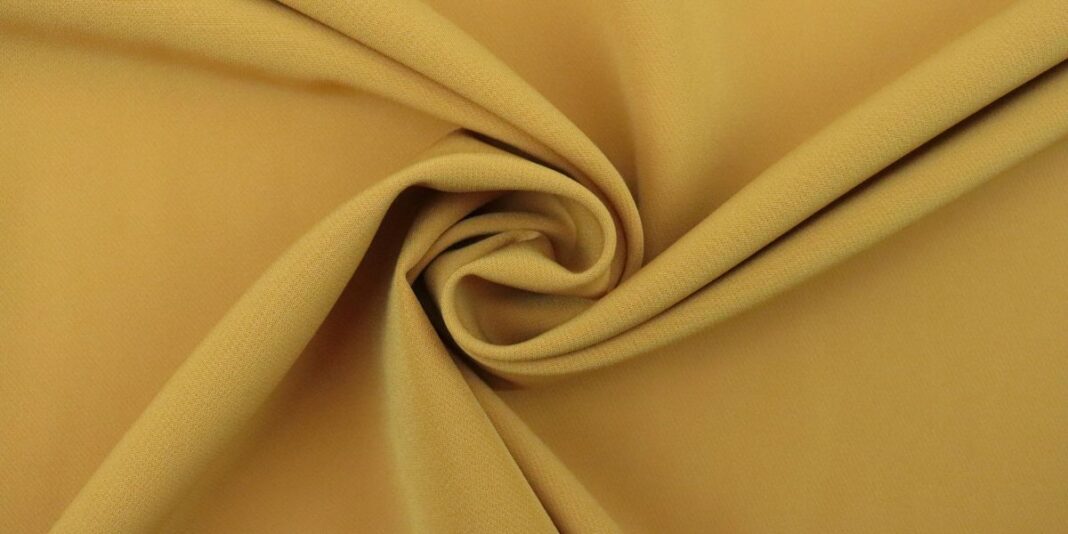Introduction
Percale cotton is a type of fabric made from cotton, woven with the percale weave of one-over-one-under repetition. The result of this type weaving is tight and consistent, yielding a matte and crisp blend. Unlike overly soft, shiny, or glossy sheets, percale gives a cool, smooth, and breathable texture that many sleepers prefer.
It is becoming more common in the bedding sector. Nowadays, percale is used in luxury hotels and in everyday home linens. People still often select it for its refreshing feel, cleaning ease, and long lasting quality.
In addition, these materials are valued for their luxurious comfort, frequent washing does not degrade percale cotton. For those who take sleep seriously, percale’s durability features alongside these qualities make it a smart long-term investment.
Why is Percale Cotton Different?

Distinctive Weave of Percale
What makes percale percale cotton is its unique weave. The weave uses one-yarn-over, one-yarn-under pattern which is distinct and easily identifiable. The structure creates a flat surface that is crisp with a matte finish, something percale is well known for. Sateen, on the other hand, is glossier and silkier as compared to percale which remains cool and fresh.
The close-knit weave provides the fabric with the well known crunchiness and firmness, making it breatheable yet structured. Most people contrive it to feel as the bedsheets in high-end hotels.
Comparison with Other Weaves
Percale cotton differs from other popular weaves like sateen and twill. For example, the smooth and glossy finish of sateen is due to a three-over-one weave. Fabrics made of twill have diagonal ribbing which makes them softer and warmer but less breathable.
In contrast, percale is lighter and gives a crisp sensation against the skin. The difference in texture and temperature makes percale ideal for summer, or for those who prefer a cooler sleep experience.
Ideal Thread Count for Percale
Often confused, thread count with percale cotton is best at a range of 200 to 400. Anything below or above this range would either compromise its breathability, durability or smoothness.
Brand unawareness of quality can lead to the misconception that higher number translates to better value — especially for percale. Instead, too high a count would rather be counter productive by decreasing breathability. Remember to prioritize weave and quality of cotton instead of focusing on just thread count.
Benefits of Percale Cotton
Breathability: Best for Hot Sleepers
The breathability of percale cotton is unarguably one of its most favorable attributes. Because it is well woven, air circulation is unrestricted. As a result, your bed remains cool for a longer period of time.
This attribute also makes percale stheets ideal for hot sleepers and people residing in regions with higher temperatures. These sheets continue to provide comfort during summers by wicking away heat and moisture efficiently.
Durability: Built to Last
Percale cotton’s strong weave gives it an advantage over wear and tear. It can endure multiple washes and maintain its structure, as well as resist pilling and holding its shape over time.
This also means that in the case of percale, there are lower replacement costs in the long run, proving to be an economical and eco-friendly solution for comfort with longevity.
Softness: Improves with Every Wash
Percale cotton starts off crisp and smooth. To your delight, it only becomes softer after every wash. Many fabrics lose their quality over time, in this case percale becomes more comfortable.
This evolving texture is appealing to anyone who cares for natural softness. Such individuals can enjoy lasting quality with the addition of improvement with age.
Hypoallergenic – Kind to Skin
Perhaps one of the best benefits is being hypoallergenic. Since percale is typically produced from long-staple cotton, it is skin friendly and does not trap allergens like dust mites and other synthetic fibers.
This is especially good for those with allergies, asthma, or sensitive skin. Resting on breathable cotton during sleep means lesser irritants and heightened comfort.
Low Maintenance – Simple to Maintain
Percale cotton is relatively low maintenance compared to other fabrics. It is more resistant to wrinkles than sateen. While some ironing may still be necessary, the fabric maintains its shape quite well.
Moreover, percale does not require any special treatments or pricey detergents. It always feels and looks fresh with a bit of effort.
Percale Cotton vs Other Fabrics
Percale vs Sateen
Sateen has a glossier appearance while percale has a matte finish. Sateen is warmer, smoother, and often gets preference in winter. Unlike sateen, percale is cooler and crisp making it a better choice for hot weather or for hot sleepers.
If structure and a fresh feel are priorities, percale wins. But if softness and shine are preferred, sateen might be more your way.
Percale vs. Linen
Linen is more textured compared to flax and has a rougher appearance. While both fabrics are breathable, linen feels heavier, with a more rustic touch. Percale is more structured and smoother.
Also, lighter in weight, percale is easier to iron. If you are looking for elegant and effortless sheet sets, percale provides a better experience.
Percale vs. Polyester Blends
Polyester blends have a lower cost, but these are not as breathable when compared to percale. They retain heat and may feel artificial. Percale cotton is natural, so it stays cooler and is kinder to the skin.
Additionally, polyester blends tend to pill with wear. With proper care, percale’s breathability and longevity outlasts polyester’s mechanical durability.
How to Identify High-Quality Percale Cotton

Choose Long-Staple Cotton
To ensure the highest quality percale cotton, seek out long-staple fibers such as Egyptian, Pima, or Supima. Long staple fibers help create smooth and strong threads that enhance both comfort and durability.
You will receive long-staple cotton’s premium softness without fraying and pilling over time. With long-staple cotton sheets, you gain softness, durability, and resilience from the very start.
Ideal Thread Count: 200-400
As described before, thread count is important but only up to a certain level. In case of percale, an optimal range is from 200 to 400. This helps keep the cotton sheets breathable and also increases the life of the sheets.
Stay away from marketing hype that claims 800+ thread count. Usually, high numbers are associated with poor quality because they use low-quality multi-ply threads to artificially increase the number.
Certifications Matter
Look for OEKO-TEX or GOTS cetification when buying percale sheets. These labels certify that the cord is free from harmful fabric and support sustainable and ethical practices.
Bedding with certification is best for personal health damages and the planet.
Best Uses of Percale Cotton
Bed Sheets – The Most Common Use
Percale cotton is mostly used in everyday bed sheets used by several people. These sheets are breathable and crisp, making beds more comfortable. They are great for summer or for people who like cool beddings.
Also, percale sheets can suit both minimalist and luxury styles making these widely adaptable. Their clean finish makes them fit any kind of decor.
Pillowcases and Duvet Covers
Staying cool is essential during the night, and percale pillowcases do just that. They don’t irritate sensitive skin, plus they don’t cause frizz to hair. Duvet covers made out of percale are lightweight and simple to layer.
Breathability works well in all seasons because there is no bulk that adds weight, making it easier to wear many different outfits on top of each other.
Lightweight Clothing
Clothing made out of percale includes shirts, dresses, and even pajamas due to being highly lightweight. The wear and tear on the fabric will be forgiven because it’s made out of percale, its reputation preceeds it. The material will feel fresh as you put it on.
Those who enjoy uniquely structured outfits that are provided breathability will be able to enjoy wearing them in any warm weather.
How to care for percale cotton.
Washing Tips
Separating percale cotton with the rest of your laundry is key to keeping it white, if you want to keep any colors in your clothes. Wearing pop colored outfits won’t damage the material, and neither will low temp washing. Plus, wearing soft clothes could cause damage.
Using the gentlest cycle helps keep the tight weave and crisp feel. Following labels is key as they contain exact instructions for every clothing item.
Drying Recommendations
Air drying works the best, but dryer on low heat works too. High heat causes damage to the fibers, so avoiding it is always best. Sheets should also be removed right after low heat drying at least to reduce wrinkles and folding them while damp helps retain their shape.
Ironing (Optional)
The fabric may be ironed if needed, though it does not require it. For the best results, a medium temperature with steam works best. It will give the sheets a polished look associated with hotels without harming the material.
Common Myths about Percale Cotton
“Higher Thread Count Is Better”
This is especially false when it comes to percale. The quality of the cotton and the way it is woven make it durable. Too high of a thread count can negatively impact the ability to breathe.
Stick to the recommended range of 200-400 for optimal performance.
“Percale Is Rough”
Many people believe percale to be stiff and scratchy. This fabric does soften with each wash, and with time, it becomes one of the most comfortable bedding options.
“Only for Summer”
While percale is good for hot sleepers, it remains a good option the entire year. In the winter months, you can pair it with thicker blankets for added warmth.
Where toExecute Purchase Percale Cotton?
Online Retailers
Sheets made of percale cotton are available in numerous listings across the internet, including Amazon and Target. Brand specific pages, like Brooklinen, also sell it. Online stores have customer reviews as well as product specifications aiding prospective customers in making the right purchasing decision.
In-Store Options
Macy’s and Nordstrom’s stores along with Bed Bath & Beyond serve ids ideal to patrons wanting to touch and feel fabrictogtheresimulates. Most, if multidimensionalenssional stores have sample display sections exhibiting fabric swatches where prospective buyers can feel and test the fabric texture before they buy.
Conclusion
Learning the characteristics of percale cotton helps you appreciate its quality, especially when purchasing bedding. Its distinctive weave pattern, one-over-one-under, together with its fresh, crisp texture make percale cotton stand out as a premium fabric which combines comfort, style and durability. Have you ever wondered why some luxury hotels are cool and clean? This perception often comes from using percale sheets.
The most attractive feature that percale cotton offers is that it can be worn in any season of the year. Of Note, it is common for textiles to be lightweight, breathable and versatile for hot sleepers and during summer months, but, percale works perfectly even in the cold months. Simply, combining it with blankets or heavier duvet ensures warmth with no overheating.
.
FAQs
Shrinks a bit with improper washing techniques. Cold water paired with low heat drying significantly reduces fabric shrinkage.
With proper care, percale cotton bedding can last several years while still feeling great.
Yes. Its breathability makes it a top pick for people who tend to overheat at night.


